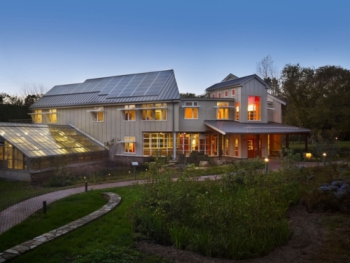Apr 23 2013
This Earth Day, Stroud Water Research Center announced that its Moorhead Environmental Complex has achieved LEED® Platinum, the highest level of certification established by the U.S. Green Building Council and verified by the Green Building Certification Institute (GBCI). LEED (Leadership in Energy and Environmental Design) is the nation's preeminent program for the design, construction, and operation of high-performance green buildings.
 Stroud Water Research Center has achieved LEED Platinum for its Moorhead Environmental Complex, a new green building for environmental education and public outreach that models sustainable practices for managing water. (PRNewsFoto/Stroud Water Research Center)
Stroud Water Research Center has achieved LEED Platinum for its Moorhead Environmental Complex, a new green building for environmental education and public outreach that models sustainable practices for managing water. (PRNewsFoto/Stroud Water Research Center)
"We're delighted to have achieved LEED Platinum, the highest honor in LEED certification," said Director, President, and Senior Research Scientist Bernard W. Sweeney , Ph.D. "The Moorhead Environmental Complex was a huge undertaking. It combined creative, cutting-edge architectural and mechanical design with other innovative environmental approaches like 'getting the water right,' which became our guiding principle in pursuit of a new green building for environmental education and public outreach that would model sustainable practices for managing water."
Since 1967, the Center has been pioneering groundbreaking research in the field of freshwater science; that research has yielded valuable insights into how streams and rivers work and how their health can be impaired as well as restored and preserved. As companions to its research, the Center has also developed education and watershed restoration programs to advance knowledge and stewardship of fresh water.
While the Moorhead Environmental Complex houses the Center's departments of education, watershed restoration, development, communications and marketing, facilities, and administration, it also serves as a teaching tool, providing opportunities for educators to discuss the various features such as wetland treatment of wastewater, rainwater capture, geothermal heating and cooling, photovoltaic panels, and landscaping that promotes infiltration.
Last fall alone, when the Moorhead Environmental Complex first opened, more than 1,000 people, mostly students and teachers who came to the Center to participate in the Stream Study Program, learned first hand how a building can be beautiful, functional, and sustainable.
By conserving energy and water, LEED certified buildings save money for families, businesses, and taxpayers; reduce greenhouse gas emissions; and contribute to a healthier environment for residents, workers, and the larger community.
"The green building movement offers an unprecedented opportunity to respond to the most important challenges of our time, including global climate change, dependence on nonsustainable and expensive sources of energy and threats to human health," said Rick Fedrizzi , president, CEO, and founding chair, U.S. Green Building Council. "The work of innovative building projects such as the Moorhead Environmental Complex is a fundamental driving force in the green building movement."
"Stroud Water Research Center has displayed an unwavering commitment to create new facilities that reflect the highest possible environmental responsiveness and to use them as an educational resource for all," said Sandy Wiggins , owner's representative for the Center and past chairman of the U.S. Green Building Council. "The project itself is a living laboratory for Stroud's study of water and the environment. This is consistent with everything I've come to know about the Center's work in the world. As an organization, they embody everything that the LEED Platinum certification represents, and I look forward to their ongoing contribution to the body of knowledge that is transforming the built environment."
LEED certification of the Moorhead Environmental Complex was based on a number of green design and construction features that positively impact the project itself and the broader community. Some of the green features on site include:
- stormwater management using natural landscaping with porous surfaces, a green roof, a rooftop rainwater capture system, and rain gardens with native vegetation;
- sustainable water use and treatment via water-efficient fixtures, a rooftop rainwater capture system feeding water-efficient toilets, a wetland wastewater treatment system, and several composting toilets;
- overall energy efficiency via a geothermal system, radiant heating, natural ventilation, solar power, high-efficiency windows, sunshades, soy-based spray-foam insulation, and recycled slag mineral wool interior insulation; and
- recycled and locally sourced materials, indoor environmental quality via low-emitting materials, efficient and task-specific lighting, and maximum use of natural ventilation and light.
Especially notable is the rainwater capture system, which is used to flush toilets and provide a water source for the Center's chemistry labs. It will also be assessed for use as a source of potable water.
Muscoe Martin , the project's architect and design team leader, noted that the Center's commitment to "getting the water right" was a major impetus for many of the design solutions: "We felt the Center deserved a building and site design that reflected its world-class research. Our team worked with Center staff and board members to develop a design that demonstrates how architecture can be integrated into the landscape to be environmentally sensitive and inspiring."
Tom Nason of Nason Construction, Inc. said, "We're excited to be a part of the team that worked on the Moorhead Environmental Complex. It's an honor to work with an organization like Stroud Water Research Center."
The design and engineering team included M2 Architecture, Meliora Environmental Design, Andropogon Associates, Bruce E. Brooks & Associates, Ann Rothmann Structural Engineering, LLC, Biohabitats, and David Nelson & Associates, LLC, Nason Construction, Inc. was the general contractor, and Consilience, LLC was the owner's representative.
In addition, educational opportunities have been maximized using educational and interpretive signage that appears on or near innovative building and landscaping solutions.
Education Director Susan Gill , Ph.D., said, "With two new classrooms, educational signage, and the green features that our educators can utilize as teaching tools, school and community groups who come to the Center will learn not just about environmental science but also environmental stewardship and how they too can be a part of the solution."
To learn more, go to: http://www.stroudcenter.org/mec/